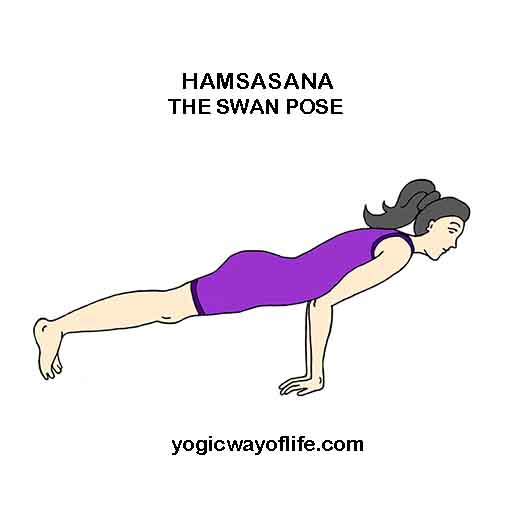Hamsasana or “Swan Pose” is a yoga asana which resembles a swan when performed. Benefits of Hamsasana range from improved digestion to strengthening of the arms and abdominal muscles. In Sanskrit, ‘Hamsa’ means the swan and hence the name Hamsasana.
How to do Hamsasana (The Swan Pose)
- Hamsasana should be performed on an empty stomach. Make sure there is a gap of 4 to 5 hours after a heavy meal.
- Assume the kneeling position with the legs slightly apart.
- Keep both the hands between the knees on the ground. The hands should point backwards towards the legs.
- Rest your elbows on your abdomen. Let your abdominal muscles assume the weight of the upper body. The elbows should be kept together.
- Take the legs backwards in a full stretch, one at a time.
- Make the body straight like a plank and use the toes to balance the weight of your legs. Keep the legs together.
- The body should be straight and make sure that your knees are not bent.
- In the final position, the entire weight of the body is supported by the toes and the palms on the ground.
- Head and neck should be kept straight to be in line with the body.
- In the beginning you may try this position for 10 – 30 seconds. Once you are comfortable, you may increase it as per your capacity.
- Keep your awareness on the abdomen and breathe normally.
Benefits of Hamsasana (The Swan Pose)
- In Hamsasana, the weight of the upper body rests on the abdomen. This strengthens the abdominal muscles and helps to reduce the belly.
- It gives strength to the arms.
- The pressure on the belly massages all the organs in the abdomen.
- It improves digestion and clears constipation.
Hamsasana is very similar to Mayurasana or the Peacock pose. In fact, Hamsasana can be used as a preparatory pose for learning Mayurasana. Try to master Hamsasana first. Once you are able to maintain the position for at least 1 minute, then you can attempt Mayurasana. Take your own time. Make sure you are not straining the arms too much. Discontinue if there is any pain in the arms and shoulders. This asana puts lot of weight on the arms and toes. Those with recent problems like fractures, sprains and ligament tears in arms or legs should not attempt this asana. Also, those who are obese should be extra careful as the entire weight will rest on the belly, arms and toes. Hamsasana will certainly help to reduce the belly, but it has to be taken up slowly. Start with few seconds and then increase the duration to a minute or more, according to your comfort and ability.
Once you have mastered Hamsasana, Mayurasana won’t be difficult. The only difference is that in Mayurasana, one has to lift both the legs above the ground. The body and the legs are made parallel to the ground and the full body weight rests on the arms and abdomen alone. This is difficult in the beginning. Start with few seconds and later increase it according to your capacity. The benefits of Mayurasana are similar to that of Hamsasana.

